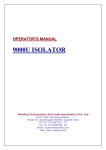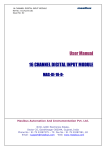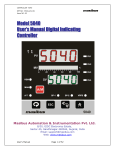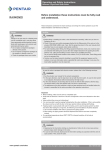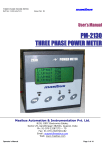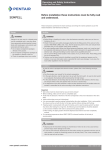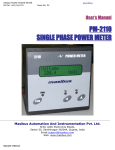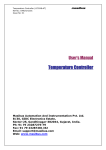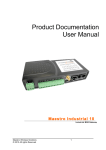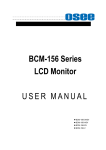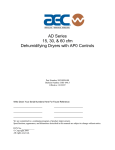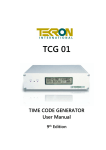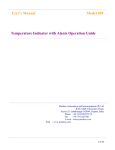Download masibus - Instrumentation and Automation Solutions
Transcript
Operation Manual TIME DISTRIBUTION RACK - 4 Masibus Automation And Instrumentation Pvt. Ltd. B/30, GIDC Electronics Estate, Sector-25, Gandhinagar-382044, Gujarat, India Ph: 91 79 23287275 - 79 Fax: 91 79 23287281, 82 Email: [email protected] Web: www.masibus.com masibus Time Distribution Rack-4 Ref No: m03/om/101 Issue No: 02 02 (6) SPECIFICATION 6.1 Common Features 6.2 Individual Specification 6.2.1 Power Supply Card 6.2.2 1PPS/IRIG B TTL Card 6.2.3 IRIG B Modulation Card 6.2.4 RS-232 Card 6.2.5 EVENT Card 03 Figures & Tables Contents (1)INTRODUCTION/OVERVIEW 1.1 Purpose of the Manual 1.2 Product Overview / Description (2) SAFETY / WARNING PRECAUTIONS 2.1 Safety Precautions 2.2 Warning Precautions (3) FRONT AND REAR PANEL PICTURE 04 3.1 Front Panel 3.2 Rear Panel 3.3 Mounting Detail (4) USER CONFIGURATION 06 4.1 Switch Selection 4.2 Default Relay Input Condition 4.3 Panel Switching Logic (5) COMMUNICATION DETAILS 5.1 5.2 5.3 5.4 The 1PPS Signal The EVENT Signal IRIG-B Signals RS-232 Outputs Operator’s Manual 09 12 Front Panel of TDR-4 Back Panel of TDR-4 Input Panels of TDR-4 Mounting Detail of TDR-4 Switch Selection IRIG B Modulated Signal Block Diagram of 1PPS/IRIG B TTL Card Figure8: Block Diagram of IRIG B Modulation Card Figure9: Block Diagram of RS 232 Card Figure10: Block Diagram of EVENT Card Figure1: Figure2: Figure3: Figure4: Figure5: Figure6: Figure7: Table Table Table Table Table 1: 2: 3: 4: 5: Switch Selection IRIG B Code Sequence RMC Record Selection NGTS Format T Format Page 1 of 17 04 04 05 05 06 10 13 14 15 16 07 10 11 11 12 masibus Time Distribution Rack-4 Ref No: m03/om/101 Issue No: 02 Note: Information in this manual is subject to change without notice or permission. prior Warning Symbol The symbol calls attention to the operating procedure, practice or the like which if not correctly performed or adhered to , could result in personal injury or damage to or destruction of part or all of the product and system. Do not proceed beyond a warning symbol until the indicated condition are fully understood and met. Class-2 Type of Instrument Note: Class-2 – Instrument is using Line & Neutral for Power Supply Input. 1. INTRODUCTION 1.1. Purpose of The Manual: How to read this manual??? Installer: Read Chapters 1, 3, 4. System Designer and New User: Read All Chapters Expert User: Read Chapters 3, 4, 5, 6. Regarding This User’s Manual → This manual should be provided to the end user. Keep an extra copy or copies of the manual in a safe place. → Read this manual carefully to gain a thorough understanding of operating this product before starting operation. Operator’s Manual → This manual describes the functions of this product. Masibus does not guarantee the application of these functions for any particular purpose. → Under absolutely no circumstances may the contents of this manual, in part or in whole, be transcribed or copied without permission. 1.2. Product Over Description: View / → Time Distribution Rack-4 (TDR-4) is an analog system that accepts signals like 1PPS, IRIG-B TTL, IRIG-B Modulated and RS-232 from GPS Clock Product and gives four number of isolated outputs of each signal same as input. → TDR-4 is housed in a 19’’, 3U rack mounted package. It has nine output card slots and one supply card slot. → There are five different types of output cards 1PPS, IRIG-B TTL, RS232, EVENT and IRIG-B MODULATION. Any signal card can easily be inserted into any signal card slot excluding Power Supply Slot. → If user requires more than four signal outputs of any signal, user has to insert two or more respected signal output cards in signal card slots as per the requirement. → TDR-4 has also facility to interface redundant GPS Clock product incases of any failure occur with the first GPS Clock. Page 2 of 17 Time Distribution Rack-4 Ref No: m03/om/101 Issue No: 02 masibus 2. SAFETY / WARNING PRECAUTIONS and local codes and regulations. Wiring must be suitable for voltage, current, and temperature rating of the system. 2.1. Safety Precautions → Beware not terminal screws. Dangerous voltages capable of causing death are sometimes present in this instrument. Before installation or beginning of any troubleshooting procedures the power to all equipment must be switched off and isolated. Units suspected of being faulty must be disconnected and removed first and brought to a properly equipped workshop for testing and repair. Component replacement and interval adjustments must be made by a company person only. 2.2. Warning Precautions → Before wiring, verify the label for correct model number and options. → Wiring must be carried out by personnel, who have basic electrical knowledge and practical experience. → It is recommended that power of these units to be protected by fuses, circuit breakers or external over current rated at the minimum value possible. to over-tighten → Verify that the ratings of the output devices and the inputs as specified in Chapter 6 are not exceeded. → Upon receipt of the shipment remove the unit from the carton and inspect the unit for shipping damage. If any damage due to transit, report and claim with the carrier. Write down the model number and serial number for future reference when corresponding with our Customer Support Division. → Do not use this instrument in areas such as excessive shock, vibration, dirt, moisture, corrosive gases or rain. The ambient temperature of the areas should not exceed the maximum rating specified. → Provide power from a single-phase instrument power supply. If there is a lot of noise in the power line, insert an insulating transformer into the primary side of the line and use a line filter on the secondary side. As counter measures against noise, do not place the primary and secondary power cables close to each other. → All wiring must be confirmed to appropriate standards of good practice Operator’s Manual the Page 3 of 17 masibus Time Distribution Rack-4 Ref No: m03/om/101 Issue No: 02 3.0 FRONT AND REAR PANEL PICTURE 3.1 FRONT PANEL Figure 1: Front Panel of TDR-4 TDR-4 is housed in a compact 19’’, 3U rack mounted package. facilitated with the provision of direct 24V DC supply on demand by customer. Figure 1 shows the front panel of the Time Distribution Rack. There are different five types of output cards available which are 1PPS, IRIG-B TTL, IRIG-B MODULATION, EVENT and RS232. Each card has one LED which shows the power status of the card and four numbers of isolated outputs with its status LED which shows the status of the signal. There is also one card for the power supply of the TDR-4. TDR-4 can take power from the main (230 V AC) by Allied standard connector with fuse, filter and On/Off switch. Instrument is also If user requires more than four number of outputs then user has to insert another same type of the card in any slot of the TDR-4, thus user has maximum 36 outputs of one signal if all the nine cards are same type. 3.2 REAR PANEL A–> L/+ B–> E C–>N/- 85V TO 265V AC 120V TO 370VDC Figure 2: Back Panel of TDR – 4 Operator’s Manual Page 4 of 17 masibus Time Distribution Rack-4 Ref No: m03/om/101 Issue No: 02 Panel – 2 Panel – 1 Figure 3: Input Panels of TDR-4 The different inputs are connected to the back panel of the TDR-4. Back panel has also different jumper for the output selection. There are two input panels available for user. The inputs are 1PPS, IRIG-B TTL, IRIG-B modulated and RS-232 and also POWER, GPSLOST, WATCHDOG and two EVENT contacts available as inputs which are the outputs of the GPS Clock. connected to it are directly given to the different cards inserted in the TDR-4 in case of only one GPS Clock is connected. TDR-4 has facility to connect redundant GPS Clock with TDR-4. TDR-4 selects one of the Two GPS and takes all the signals of that GPS as input and gives that signal to the different cards for further distribution of the signals. The selection of the GPS is based on different inputs given by the GPS. The input panel - 1 which is near to the fan is the default panel and inputs 3.3 MOUNTING DETAIL m a sib u s Figure 4: Mounting Detail of TDR-4 4.0 USER CONFIGURATION Operator’s Manual Page 5 of 17 masibus Time Distribution Rack-4 Ref No: m03/om/101 Issue No: 02 4.1 SWITCH SELECTION Figure 5: Switch Selection Figure 5 shows the lay out of the Switch available at the back plate of the TDR-4. The configuration of each jumper is as shown below. Use Switch Panel No Name SW10 is used to select the mode of the TDR-4. SW10_1 OFF and SW10_2 ON for without Redundant I/Ps TDR. SW 10 SW10_1 ON and SW10_2 OFF for with Redundant I/Ps TDR. BOTH CHANNLE J19 & J20 is used to use 1PPS as PFC output. This output is available as an EVENT so user has to insert EVENT card to use this J19 & output. J20 Short pin 1 and 2 for 1PPS as PFC. Short pin 2 and 3 for normal Event output. SW1 & SW7 are used to select inverted or non inverted logic of the POWER 1 input. SW1 & SW7 SW1_1 ON and SW1_2 OFF for inverted logic for POWER 1 input and SW7_1 OFF. SW1_1 OFF and SW1_2 ON for non inverted logic for POWER 1 input and SW7_1 ON. SW2 & SW7 are used for inverted or non inverted logic of the WATCHDOG 1 input. Channel - 1 SW2 & SW7 SW2_1 ON and SW2_2 OFF for inverted logic for WATCHDOG 1 input and SW7_2 OFF. SW2_1 OFF and SW2_2 ON for non inverted logic for WATCHDOG 1 input and SW7_2 ON. SW3 & SW8 are used for inverted or non inverted logic of the GPS LOST 1 input. SW3 & SW8 SW3_1 ON and SW3_2 OFF for inverted logic for GPS LOST 1 input and SW8_1 OFF. SW3_1 OFF and SW3_2 ON for non inverted logic for GPS LOST 1 input and SW8_1 ON. Channel - 2 Operator’s Manual SW4 & SW8 SW4 & SW8 are used to select inverted or non inverted logic of the POWER 2 input. Page 6 of 17 masibus Time Distribution Rack-4 Ref No: m03/om/101 Issue No: 02 SW4_1 ON and SW4_2 OFF for inverted logic for POWER 2 input and SW8_2 OFF. SW4_1 OFF and SW4_2 ON for non inverted logic for POWER 2 input and SW8_2 ON. SW5 & SW9 are used for inverted or non inverted logic of the WATCHDOG 2 input. SW5 & SW9 SW5_1 ON and SW5_2 OFF for inverted logic for WATCHDOG 2 input and SW9_1 OFF. SW5_1 OFF and SW5_2 ON for non inverted logic for WATCHDOG 2 input and SW9_1 ON. SW6 & SW9 are used for inverted or non inverted logic of the GPS LOST 2 input. SW6 & SW9 SW6_1 ON and SW6_2 OFF for inverted logic for GPS LOST 2 input and SW9_2 OFF. SW6_1 OFF and SW6_2 ON for non inverted logic for GPS LOST 2 input and SW9_2 ON. Table 1: Switch Selection 4.2 Default Relay Input Condition There are two ways of configuring Relay Input terminals at TDR-4 back Plate, i.e. noninverting mode and inverting mode. The relay input terminals for Panel-1 and Panel-2 are POWER-1, GPS LOST-1, WATCHDOG-1 and POWER-2, GPS LOST-2, WATCHDOG-2 respectively. In non-inverting mode if these terminals get shorted by Relay contacts the TDR-4 indicates fault condition. For example if GPS clock lost the GPS connection and activates its GPS LOST output Relay and thus the GPS LOST-1 terminal gets connected, the TDR-4 in non-inverting mode will glow LED of GPS LOST-1 in front of Power Supply card. The default relay condition of GPS clock for non-inverting mode of TDR-4 is expected as below Relay Condition NO/NC Power NO (Power ON) NC (Power OFF) NO (Watchdog NC (Watchdog Reset Watchdog Reset Not Available) Available) NO (GPS signal GPS Lost NC (GPS signal Lost) Healthy) For inverting Mode operation of TDR-4 Relay inputs there is switch settings as shown in Table-1. In inverting mode the relay input terminals are opened for fault LED indication. For example if GPS clock lost the Power, so at this condition the POWER-1 terminals should be opened to indicate fault LED at front of Power Supply card. The default relay condition of GPS clock for inverting mode of TDR-4 is expected as below Operator’s Manual Page 7 of 17 masibus Time Distribution Rack-4 Ref No: m03/om/101 Issue No: 02 Relay Power Watchdog GPS Lost Condition NO/NC NO (Power OFF) NC (Power ON) NO (Watchdog NC (Watchdog Reset Reset Available) Not Available) NO (GPS signal NC (GPS signal Lost) Healthy) Note: The relays of GPS clock are made wet by 5V DC from TDR-4 Relay Input Terminals. Therefore extensive care must be taken while connecting Relay input terminals of TDR-4 to any GPS clock. 4.3 Panel Switching Logic ABC DEF 000 001 011 010 100 101 111 110 000 X X X X X X 1 1 001 X X X X X X 1 1 011 X X X X X X 1 1 010 X X X X X X 1 1 100 X X X X X X 1 1 101 X X X X X X 1 1 111 0 0 0 0 0 0 0 0 110 0 0 0 0 0 0 1 0 Result of above map S2 = (AB)’ + DEFC’ Where APower On – 1 BWatch Dog – 1 CGPS Lost – 1 S2 = 0 Panel 1 is selected for output S2 = 1 Panel 2 is selected for output X= Don’t care *When relay is open it is considered as logic 1. DPower On – 2 EWatch Dog – 2 FGPS Lost – 2 For Example if Panel-1 has inputs A,B and C at logic 1,1 and 0 respectively and Pannel-2 has inputs D,E and F at logic 1,0 and 0 the equation S2 = (AB)’ + DEFC’ will result in 0 and thus the Inputs at Panel-1 will be forwarded to TDR-4 outputs. 5.0 COMMUNICATION DETAIL Operator’s Manual Page 8 of 17 masibus Time Distribution Rack-4 Ref No: m03/om/101 Issue No: 02 synchronized 1PPS time output pulse. There are two alternative forms of output, a dc level shift output, and a modulated output. The modulation frequency is 1 KHz. 5.1 The 1PPS Signal This is a very important timing signal. It is the TTL level pulse with a width of 200ms isolated output coming from the GPS receiver. This 1PPS is connected to the BNC connector on the rear panel. For each form of output there are three output codes:a. A Reference Mark b. A logical 1 c. A logical 0 5.2 The Event Signal The signal is an isolated event output through a static relay contact. This signal is connected to two of the terminal of the 8 way barrier strip on the rear panel of the Instrument. The event is assigned as isolated event; the frequency for this event can be configured from GPS receiver as 1 minute or 1 hour. The pulse width of the event is 2 second. For IRIG-B, each one of these codes is 10 ms long, which is 10 cycles for the modulated format. There are 100 possible codes per time frame, although not all of them are used. The code sequence is shown in Table 1, and the waveforms shown in Figure 2. The day number starts at 1 on the first of January. TDR-4 has facility of taking 2 Event inputs. There are two Event input terminals at rear of TDR-4 named EVENT-1-1 and EVENT1-2 for Panel-1 and similarly for EVENT-2-1 and EVENT2-2 for Panel-2. The output voltage of the modulated waveform is 3 V peak to peak into a 50 ohms load. The dc level output is TTL standard and the rising edge of the pulse is "On Time". 1 kHz modulated IRIG-B signal is connected to BNC on the rear panel of the device. IRIG-B TTL level signal is connected to a BNC connector on the rear panel of the device. 5.3 The IRIG-B Signal The IRIG-B format is a serial format based on a message frame per second which is Co-ordinate with the Position Type 0 1 2 3 4 5 6 7 8 9 10 11 12 13 14 15 Reference Mark Signal Signal Signal Signal Logical 0 Signal Signal Signal Reference Mark Signal Signal Signal Signal Logical 0 Signal Operator’s Manual Item Digit Seconds Seconds Seconds Seconds 1 2 4 8 Seconds Seconds Seconds 10 20 40 Minutes Minutes Minutes Minutes 1 2 4 8 Minutes 10 Position Type 27 to 28 29 30 31 32 33 34 35 36 37 38 39 40 41 42 to 48 49 Logical 0 Reference Mark Signal Signal Signal Signal Logical 0 Signal Signal Signal Signal Reference Mark Signal Signal Logical 0 Reference Mark Item Digit Day Day Day Day 1 2 4 8 Day Day Day Day 10 20 40 80 Day Day 100 200 Page 9 of 17 masibus Time Distribution Rack-4 Ref No: m03/om/101 Issue No: 02 16 17 18 19 20 21 22 23 24 25 26 Signal Signal Logical 0 Reference Mark Signal Signal Signal Signal Logical 0 Signal Signal Minutes Minutes 20 40 Hours Hours Hours Hours 1 2 4 8 Hours Hours 10 20 50 to 58 59 60 to 68 69 70 to 78 79 80 to 88 89 90 to 98 99 Logical 0 Reference Mark Logical 0 Reference Mark Logical 0 Reference Mark Logical 0 Reference Mark Logical 0 Reference Mark Table 2 – IRIG B Code Sequence Figure 6: IRIG B Modulated Signal 5.4 RS-232 Outputs There are two RS-232 serial ports equipped within the device. These two serial ports use two separate high performance chips to get electrical isolation. Each serial port has its own format of the timing strings. On serial port one, 9 ways D-type socket, the message is NMEA ($GPRMC) format. The Operator’s Manual serial port two, 9 way D-type plug, the message is NGTS or T-FORMAT. NMEA Format RMC RECORD FORMAT The $GPRMC sentence contains time and date of position fix, speed and course information. The following examples Page 10 of 17 masibus Time Distribution Rack-4 Ref No: m03/om/101 Issue No: 02 show the contents of a typical RMC sentence: The full data message of this format shall consist of data fields as follows: The settings for this serial format is 4800, 8, N, 1. Field Sentence ID Example $GPRMC, UTC Time Status Latitude N/S Indicator Longitude E/W Indicator Speed over ground Course over ground UTC Date Magnetic variation Magnetic variation Checksum Terminator Comments 130525.00, A, 4250.5589, S, 14518.5084, E, 000.1, 245.0, 291206, , , *25 <CR><LF> hhmmss.ss, A = Valid/V = Invalid, ddmm.mmmm, N = North/S = South, dddmm.mmmm, E = East/W = West, Knots, Degrees, DDMMYY, Degrees, E = East/W = West, *CC Non-printing characters Table 3: RMC Record Selection NGTS Format The settings for this format are programmable. The full data message of Description Code Identification Year in Century Month Day of Month Day of Week Hours Minutes GMT Marker Validity Marker CRLF Number of Characters 1 2 2 2 1 2 2 1 1 2 NGTS format shall consist of 14 printable characters and a concluding CRLF as follows: Character Position 1 2,3 4,5 6,7 8 9,10 11,12 13 14 15,16 Range of Value/Information Capital T 0 to 99 1 to 12 1 to 31 1 to 7 0 to 23 0 to 59 0 or 1 0 or 1 Non-printing character Table 4: NGTS Format The transmission sequence shall be from the Code Identification character through to the CRLF with the most significant digits being transmitted first. Operator’s Manual The message shall become automatically available at one second prior to the clock minute epoch. T-Format Page 11 of 17 masibus Time Distribution Rack-4 Ref No: m03/om/101 Issue No: 02 The settings for this format are programmable. The full data message of T-format shall consist of 21 printable Description Code Identification Divider Year in Century Divider Month Divider Day of Month Divider Day of Week Divider Hours Divider Minutes Divider GMT Marker Validity Marker CRLF Number of Characters 1 1 2 1 2 1 2 1 1 1 2 1 2 1 1 1 2 characters with a concluding CRLF as follows: Character Position 1 2 3,4 5 6,7 8 9,10 11 12 13 14,15 16 17,18 19 20 21 22,23 Range of Value/Information Capital T : 0 to 99 : 1 to 12 : 1 to 31 : 1 to 7 : 0 to 23 : 0 to 59 : 0 or 1 0 or 1 Non printing character Table 5: T- Format 6.0 SPECIFICATION 6.1 COMMON FEATURES The Masibus GPS signal distributor amplifies & distribute different outputs as connected to it rear side. • The equipment is housed in a compact 19’’, 3U rack mounted package • High intensity LEDs are located on the front face to show the equipment status • A Common LED for power supply ON indication • A Common LED for ALARM detection of Source signal and source instruments • • • • All the inputs are on the rear side and all the output signals are located on the front of the equipment. Hot Swappable. Consumption: 50 W [max]. The equipment take power from the main (230 V AC) by Allied standard connector with fuse, filter and On/Off switch. Instrument is also facilitated with the provision of direct 24V DC supply on demand by customer. 6.2 INDIVIDUAL SPECIFICATION 6.2.1 POWER SUPPLY CARD Operator’s Manual Page 12 of 17 masibus Time Distribution Rack-4 Ref No: m03/om/101 Issue No: 02 • • • • • • • Input Supply range 85 - 265 VAC (wide range) 120 - 370VDC Frequency 47-440 Hz Inrush current <18A peak @ 115VAC, <36 A peak @230 VAC, cold start @ 25°C Input current 1.5A max. (RMS) @ 115 VAC Efficiency 70% typical at full load Safety ground leakage current <0.5mA @ 50/60 Hz; 264VAC input Maximum power 60W for convection; 80W with 30CFM forced air • • • • Adjustment range -5, +10% minimum Hold-up time 20ms @ 60W load, 115VAC nominal line Overload protection Short circuit protection on all outputs. Compliance: FCC Class B, CISPR22 Class B, EN55022 Class B, VDE0878PT3 Class B Isolation of 500VAC Between Power and Inputs in 85 - 265 VAC supply range. 6.2.2 1PPS / IRIG B TTL Card • • • 5V TTL input level on BNC, 50Ω connector. 4 numbers of 5V TTL isolated outputs level on BNC, 50Ω connector. 4 common LEDs to show the status of each output. • • • The input pulse is distributed without any change in polarity or duration. Maximum Distance: 10 meters Isolation of 1.5KV AC between Power to Output, Input to Output and Output to Output. 1PPS/IRIG-B TTL CARD 1 PPS / IRIG B TTL Input Buffer and Distribution Circuit Isolator Circuit 1 PPS1/ IRIGB TTL 1 Isolator Circuit 1 PPS2/ IRIGB TTL 2 Isolator Circuit 1 PPS3/ IRIGB TTL 3 Isolator Circuit 1 PPS4/ IRIGB TTL 4 Figure 7: Block Diagram of 1PPS / IRIG B TTL Card Fig.7 shows the block diagram of the 1PPS/IRIG-B TTL card. The input of the card is buffered by the buffer and then four isolated outputs are provided. 6.2.3 IRIG B MODULATION CARD • Time Code Amplifier and distributor provide analog IRIG B or any other format, Time code amplification and Operator’s Manual distribution. The time codes are based on a 1 kHz amplitude modulated (1/3) sine wave carrier. Page 13 of 17 masibus Time Distribution Rack-4 Ref No: m03/om/101 Issue No: 02 • • • • • In input the equipment receives an analog signal from an external IRIG B source. When detecting an input signal, the LED SIGNAL turns ON. The amplified signal is isolated and distributed over the 4 outputs of the equipment. Each of the four isolated outputs could be adjusted. These settings are the gain of each output amplifier. The gain of each amplifier is adjusted by a dedicated potentiometer accessible from front. The output level is independently settled for each type of output. • • • • • The analog time code signal connector is a base female BNC. The input circuit impedance is more than 600 Ω. 1 KHz AM Signal 3:1 Modulation Ratio Output Impedance is more than 750Ω Isolation of 1.5KV AC between Power to Output, Input to Output and Output to Output. IRIG B Modulation Card IRIGB Modulated Input Amplifier Circuit Isolator Circuit IRIGB Modulati on 1 Amplifier Circuit Gain Control 1 Isolator Circuit IRIGB Modulati on 2 Amplifier Circuit Gain Control 2 Isolator Circuit IRIGB Modulati on 3 Amplifier Circuit Gain Control 3 Isolator Circuit IRIGB Modulati on 4 Amplifier Circuit Gain Control 4 Figure 8: Block Diagram of IRIG B Modulation Card Fig.8 shows the block diagram of the IRIG-B Modulation Card. Input of the card is first amplified by the amplified circuit then it is divided in to four isolated output with gain control circuit. 6.2.4 RS-232 CARD • • The Time frame distributor allows ASCII frame distribution on 4 serial tracks in compliance with RS-232 standard. Operator’s Manual • • A front fascia One LED shows that power supply is ON. The output data are diffused with the same characteristics of the available input data. Page 14 of 17 masibus Time Distribution Rack-4 Ref No: m03/om/101 Issue No: 02 • • • Transfer speed, parity or number of data bits, couldn’t be changed. 1 input to 4 isolated outputs mode. The input connectors are SUB'D 9 pins female and outputs are female type. • • • Isolation of 1.5KV AC between Power to Output, Input to Output and Output to Output. DB9 Female Connectors Maximum Distance of 50’ RS-232 Card Figure 9: Block Diagram of RS 232 Card Fig.9 shows the block diagram of the RS-232 Card. Input of the card is first converted in TTL level then it is divided in to four isolated output and then it is converted in to RS-232 format output. 6.2.5 EVENT CARD • • • 1 input 4 outputs. Four potential free relay outputs are available on the front fascia of the card. 4 LEDs are available which shows the status of each event. Operator’s Manual • • • One power LED shows status of the power of the card. Inverted event logic output. (refer jumper setting) 350 VAC, 120mA maximum Page 15 of 17 masibus Time Distribution Rack-4 Ref No: m03/om/101 Issue No: 02 • Isolation of 2000 MΩ at 500 VDC between Power to Output, Input to Output and Output to Output EVENT Card EVENT Input Selection Circuit for Inverted or Noninverted EVENT Isolator Relay Output EVENT 1 Isolator Relay Output EVENT 2 Isolator Relay Output EVENT 3 Isolator Relay Output EVENT 4 Figure 10: Block Diagram of EVENT Card Fig.10 shows the block diagram of the EVENT Card. Input of the card is first given to selection and inverter circuit then output of this block is divided in to four isolated output. Operator’s Manual Page 16 of 17

















